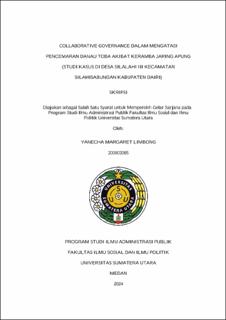| dc.contributor.advisor | Sihombing, R Sally Marisa | |
| dc.contributor.author | Limbong, Yanecha Margaret | |
| dc.date.accessioned | 2024-12-17T02:23:10Z | |
| dc.date.available | 2024-12-17T02:23:10Z | |
| dc.date.issued | 2024 | |
| dc.identifier.uri | https://repositori.usu.ac.id/handle/123456789/99471 | |
| dc.description.abstract | Floating net cages (KJA) are a container for fish maintenance in the form of a net bag that is located floating on the surface of the water, the large amount of fish feed used every day without waste management, causes the cultivation industry in the waters of Lake Toba to be an environmentally unfriendly fish cultivation industry, In accordance with Presidential Regulation Number 81 of 2014, Dairi Regency as zone A3.1 is not allowed to carry out floating net cage cultivation, the Dairi Regent formed an Integrated Team for Controlling Floating Net Cages.
The research method in this study is qualitative research with a descriptive approach. Data collection used interview, observation, and documentation techniques. The data obtained were analyzed qualitatively with the Collaboration Process theory approach According to Ansell and Gash (2007) namely 1) Face to Face, 2) Trust Building, 3) Commitment to Process, 4) Share Understanding, 5) Intermediate Outcome.
The results of the study show that in the collaboration process carried out by the Environmental Service, Tourism Service, PT Tua Ganda, and the Silalahi community, the owners of floating net cages, namely: 1) Face to face dialogue that has been implemented in the Zero floating net cage program has been running well and has been maximally attempted. 2) Trust building for each activity actor has not been carried out continuously and no trust has been built. 3) Commitment to process has not been running well, there is no responsibility from the tourism service and the community for the program. 4) Shared understanding has not been running well, information is only in the form of data on the names of the cage owners. 5) Intermediate outcomes were the dismantling of 200 plots, but there has been no follow-up regarding evaluation and monitoring in the field. | en_US |
| dc.language.iso | id | en_US |
| dc.publisher | Universitas Sumatera Utara | en_US |
| dc.subject | Collaborative Governance | en_US |
| dc.subject | Lake Toba Pollution | en_US |
| dc.subject | Floating Net Cages | en_US |
| dc.title | Collaborative Governance dalam Mengatasi Pencemaran Danau Toba Akibat Keramba Jaring Apung (Studi Kasus di Desa Silalahi III Kecamatan Silahisabungan Kabupaten Dairi) | en_US |
| dc.title.alternative | Collaborative Governance in Overcoming Lake Toba Pollution Due to Floating Net Cages (Case Study in Silalahi III Village, Silahisabungan District, Dairi Regency) | en_US |
| dc.type | Thesis | en_US |
| dc.identifier.nim | NIM200903085 | |
| dc.identifier.nidn | NIDN0003017705 | |
| dc.identifier.kodeprodi | KODEPRODI63201#Ilmu Administrasi Publik | |
| dc.description.pages | 173 Pages | en_US |
| dc.description.type | Skripsi Sarjana | en_US |
| dc.subject.sdgs | SDGs 14. Life Below Water | en_US |


